Wenjing Wang
Enhancing WiFi CSI Fingerprinting: A Deep Auxiliary Learning Approach
Oct 26, 2025Abstract:Radio frequency (RF) fingerprinting techniques provide a promising supplement to cryptography-based approaches but rely on dedicated equipment to capture in-phase and quadrature (IQ) samples, hindering their wide adoption. Recent advances advocate easily obtainable channel state information (CSI) by commercial WiFi devices for lightweight RF fingerprinting, while falling short in addressing the challenges of coarse granularity of CSI measurements in an open-world setting. In this paper, we propose CSI2Q, a novel CSI fingerprinting system that achieves comparable performance to IQ-based approaches. Instead of extracting fingerprints directly from raw CSI measurements, CSI2Q first transforms frequency-domain CSI measurements into time-domain signals that share the same feature space with IQ samples. Then, we employ a deep auxiliary learning strategy to transfer useful knowledge from an IQ fingerprinting model to the CSI counterpart. Finally, the trained CSI model is combined with an OpenMax function to estimate the likelihood of unknown ones. We evaluate CSI2Q on one synthetic CSI dataset involving 85 devices and two real CSI datasets, including 10 and 25 WiFi routers, respectively. Our system achieves accuracy increases of at least 16% on the synthetic CSI dataset, 20% on the in-lab CSI dataset, and 17% on the in-the-wild CSI dataset.
Stand-In: A Lightweight and Plug-and-Play Identity Control for Video Generation
Aug 12, 2025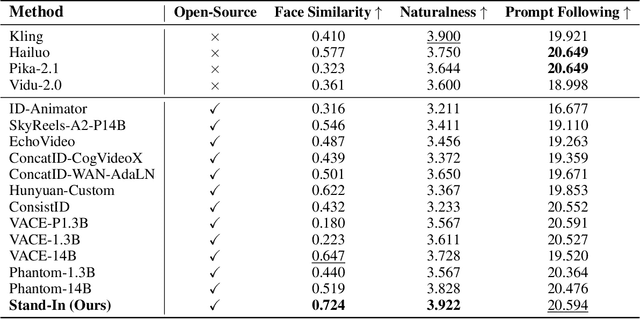
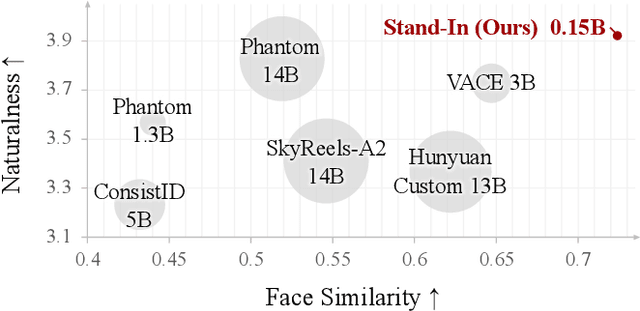
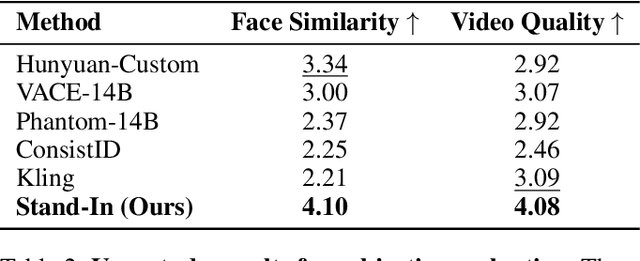

Abstract:Generating high-fidelity human videos that match user-specified identities is important yet challenging in the field of generative AI. Existing methods often rely on an excessive number of training parameters and lack compatibility with other AIGC tools. In this paper, we propose Stand-In, a lightweight and plug-and-play framework for identity preservation in video generation. Specifically, we introduce a conditional image branch into the pre-trained video generation model. Identity control is achieved through restricted self-attentions with conditional position mapping, and can be learned quickly with only 2000 pairs. Despite incorporating and training just $\sim$1% additional parameters, our framework achieves excellent results in video quality and identity preservation, outperforming other full-parameter training methods. Moreover, our framework can be seamlessly integrated for other tasks, such as subject-driven video generation, pose-referenced video generation, stylization, and face swapping.
DECO: Life-Cycle Management of Enterprise-Grade Chatbots
Dec 08, 2024



Abstract:Software engineers frequently grapple with the challenge of accessing disparate documentation and telemetry data, including Troubleshooting Guides (TSGs), incident reports, code repositories, and various internal tools developed by multiple stakeholders. While on-call duties are inevitable, incident resolution becomes even more daunting due to the obscurity of legacy sources and the pressures of strict time constraints. To enhance the efficiency of on-call engineers (OCEs) and streamline their daily workflows, we introduced DECO -- a comprehensive framework for developing, deploying, and managing enterprise-grade chatbots tailored to improve productivity in engineering routines. This paper details the design and implementation of the DECO framework, emphasizing its innovative NL2SearchQuery functionality and a hierarchical planner. These features support efficient and customized retrieval-augmented-generation (RAG) algorithms that not only extract relevant information from diverse sources but also select the most pertinent toolkits in response to user queries. This enables the addressing of complex technical questions and provides seamless, automated access to internal resources. Additionally, DECO incorporates a robust mechanism for converting unstructured incident logs into user-friendly, structured guides, effectively bridging the documentation gap. Feedback from users underscores DECO's pivotal role in simplifying complex engineering tasks, accelerating incident resolution, and bolstering organizational productivity. Since its launch in September 2023, DECO has demonstrated its effectiveness through extensive engagement, with tens of thousands of interactions from hundreds of active users across multiple organizations within the company.
Zero-Reference Low-Light Enhancement via Physical Quadruple Priors
Mar 19, 2024



Abstract:Understanding illumination and reducing the need for supervision pose a significant challenge in low-light enhancement. Current approaches are highly sensitive to data usage during training and illumination-specific hyper-parameters, limiting their ability to handle unseen scenarios. In this paper, we propose a new zero-reference low-light enhancement framework trainable solely with normal light images. To accomplish this, we devise an illumination-invariant prior inspired by the theory of physical light transfer. This prior serves as the bridge between normal and low-light images. Then, we develop a prior-to-image framework trained without low-light data. During testing, this framework is able to restore our illumination-invariant prior back to images, automatically achieving low-light enhancement. Within this framework, we leverage a pretrained generative diffusion model for model ability, introduce a bypass decoder to handle detail distortion, as well as offer a lightweight version for practicality. Extensive experiments demonstrate our framework's superiority in various scenarios as well as good interpretability, robustness, and efficiency. Code is available on our project homepage: http://daooshee.github.io/QuadPrior-Website/
Open-Set Facial Expression Recognition
Jan 23, 2024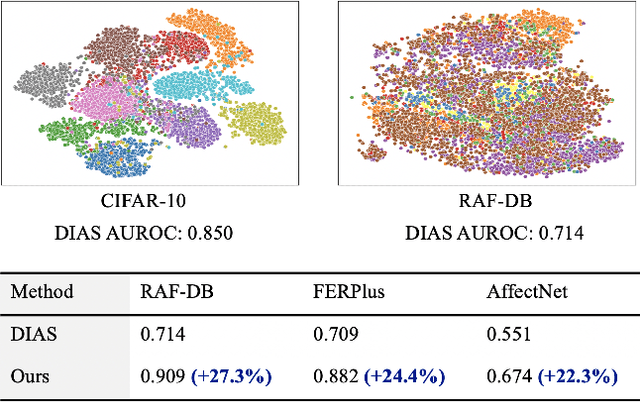

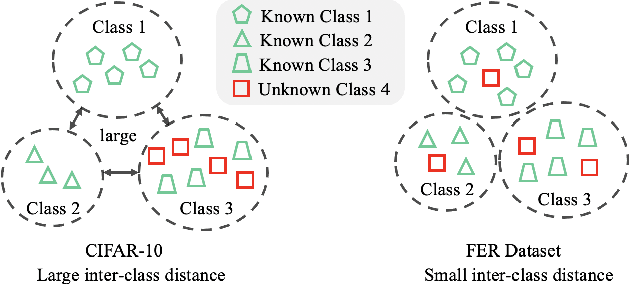
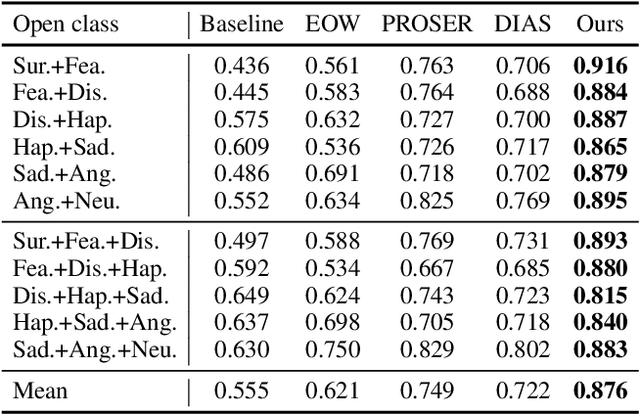
Abstract:Facial expression recognition (FER) models are typically trained on datasets with a fixed number of seven basic classes. However, recent research works point out that there are far more expressions than the basic ones. Thus, when these models are deployed in the real world, they may encounter unknown classes, such as compound expressions that cannot be classified into existing basic classes. To address this issue, we propose the open-set FER task for the first time. Though there are many existing open-set recognition methods, we argue that they do not work well for open-set FER because FER data are all human faces with very small inter-class distances, which makes the open-set samples very similar to close-set samples. In this paper, we are the first to transform the disadvantage of small inter-class distance into an advantage by proposing a new way for open-set FER. Specifically, we find that small inter-class distance allows for sparsely distributed pseudo labels of open-set samples, which can be viewed as symmetric noisy labels. Based on this novel observation, we convert the open-set FER to a noisy label detection problem. We further propose a novel method that incorporates attention map consistency and cycle training to detect the open-set samples. Extensive experiments on various FER datasets demonstrate that our method clearly outperforms state-of-the-art open-set recognition methods by large margins. Code is available at https://github.com/zyh-uaiaaaa.
MobileVidFactory: Automatic Diffusion-Based Social Media Video Generation for Mobile Devices from Text
Jul 31, 2023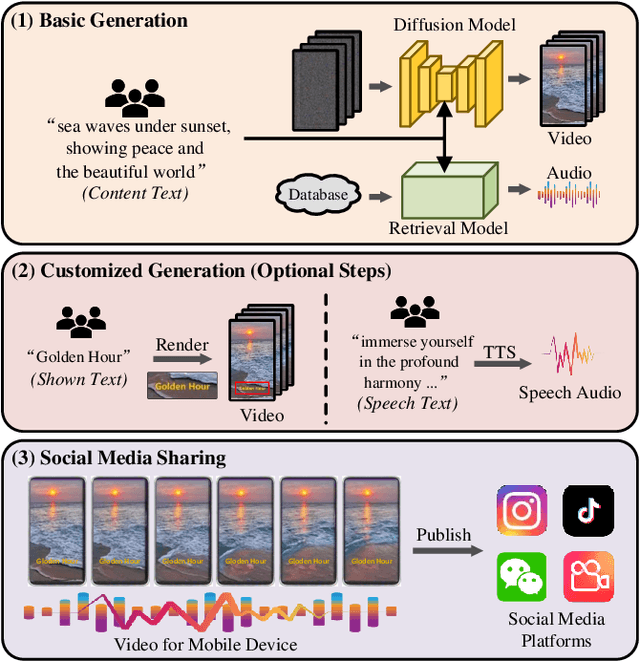
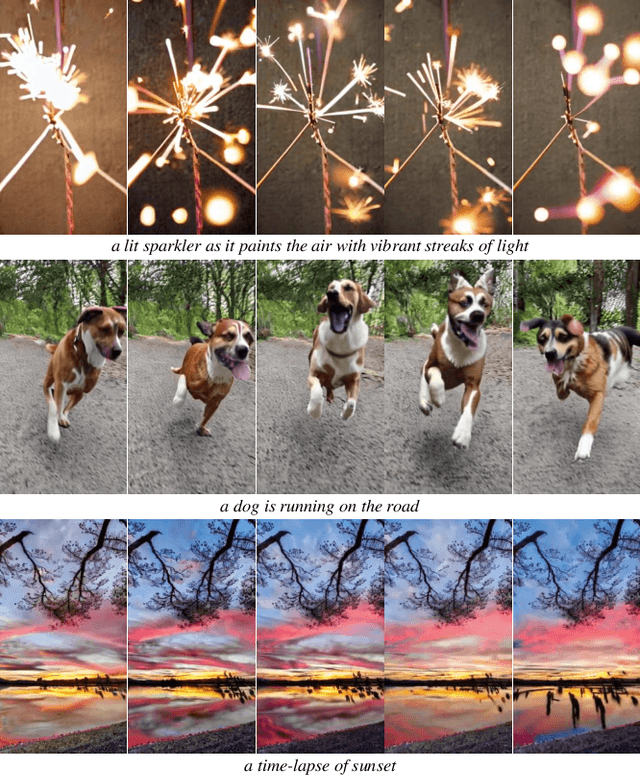
Abstract:Videos for mobile devices become the most popular access to share and acquire information recently. For the convenience of users' creation, in this paper, we present a system, namely MobileVidFactory, to automatically generate vertical mobile videos where users only need to give simple texts mainly. Our system consists of two parts: basic and customized generation. In the basic generation, we take advantage of the pretrained image diffusion model, and adapt it to a high-quality open-domain vertical video generator for mobile devices. As for the audio, by retrieving from our big database, our system matches a suitable background sound for the video. Additionally to produce customized content, our system allows users to add specified screen texts to the video for enriching visual expression, and specify texts for automatic reading with optional voices as they like.
Similarity Min-Max: Zero-Shot Day-Night Domain Adaptation
Jul 19, 2023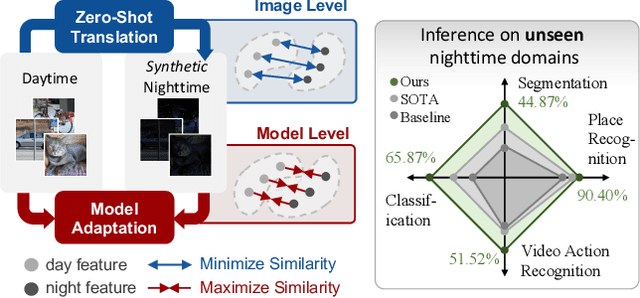
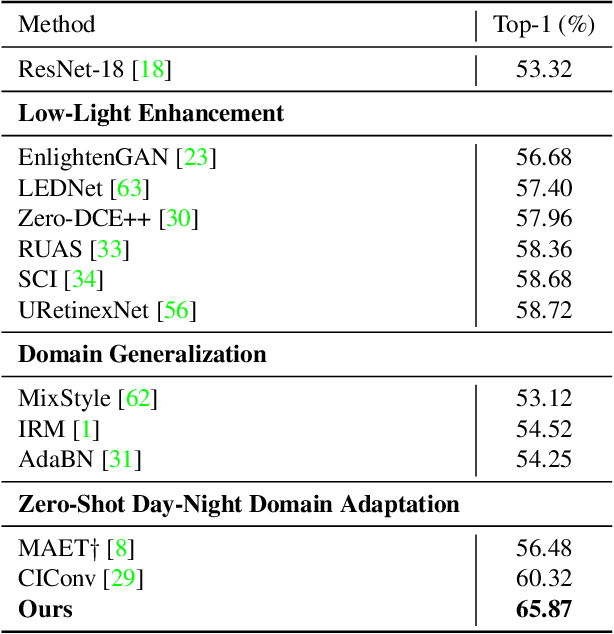
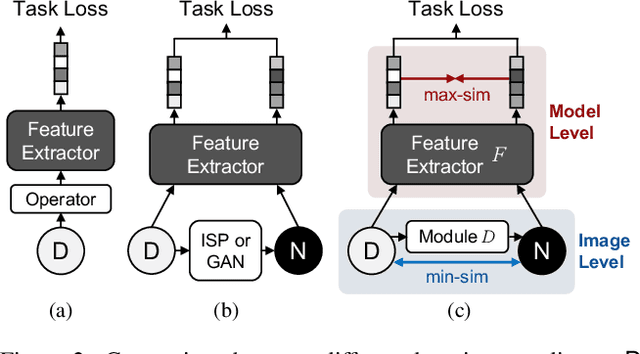
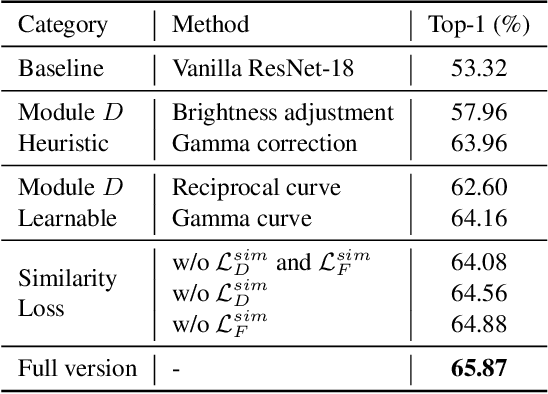
Abstract:Low-light conditions not only hamper human visual experience but also degrade the model's performance on downstream vision tasks. While existing works make remarkable progress on day-night domain adaptation, they rely heavily on domain knowledge derived from the task-specific nighttime dataset. This paper challenges a more complicated scenario with border applicability, i.e., zero-shot day-night domain adaptation, which eliminates reliance on any nighttime data. Unlike prior zero-shot adaptation approaches emphasizing either image-level translation or model-level adaptation, we propose a similarity min-max paradigm that considers them under a unified framework. On the image level, we darken images towards minimum feature similarity to enlarge the domain gap. Then on the model level, we maximize the feature similarity between the darkened images and their normal-light counterparts for better model adaptation. To the best of our knowledge, this work represents the pioneering effort in jointly optimizing both aspects, resulting in a significant improvement of model generalizability. Extensive experiments demonstrate our method's effectiveness and broad applicability on various nighttime vision tasks, including classification, semantic segmentation, visual place recognition, and video action recognition. Code and pre-trained models are available at https://red-fairy.github.io/ZeroShotDayNightDA-Webpage/.
MovieFactory: Automatic Movie Creation from Text using Large Generative Models for Language and Images
Jun 12, 2023Abstract:In this paper, we present MovieFactory, a powerful framework to generate cinematic-picture (3072$\times$1280), film-style (multi-scene), and multi-modality (sounding) movies on the demand of natural languages. As the first fully automated movie generation model to the best of our knowledge, our approach empowers users to create captivating movies with smooth transitions using simple text inputs, surpassing existing methods that produce soundless videos limited to a single scene of modest quality. To facilitate this distinctive functionality, we leverage ChatGPT to expand user-provided text into detailed sequential scripts for movie generation. Then we bring scripts to life visually and acoustically through vision generation and audio retrieval. To generate videos, we extend the capabilities of a pretrained text-to-image diffusion model through a two-stage process. Firstly, we employ spatial finetuning to bridge the gap between the pretrained image model and the new video dataset. Subsequently, we introduce temporal learning to capture object motion. In terms of audio, we leverage sophisticated retrieval models to select and align audio elements that correspond to the plot and visual content of the movie. Extensive experiments demonstrate that our MovieFactory produces movies with realistic visuals, diverse scenes, and seamlessly fitting audio, offering users a novel and immersive experience. Generated samples can be found in YouTube or Bilibili (1080P).
VideoFactory: Swap Attention in Spatiotemporal Diffusions for Text-to-Video Generation
May 18, 2023



Abstract:We present VideoFactory, an innovative framework for generating high-quality open-domain videos. VideoFactory excels in producing high-definition (1376x768), widescreen (16:9) videos without watermarks, creating an engaging user experience. Generating videos guided by text instructions poses significant challenges, such as modeling the complex relationship between space and time, and the lack of large-scale text-video paired data. Previous approaches extend pretrained text-to-image generation models by adding temporal 1D convolution/attention modules for video generation. However, these approaches overlook the importance of jointly modeling space and time, inevitably leading to temporal distortions and misalignment between texts and videos. In this paper, we propose a novel approach that strengthens the interaction between spatial and temporal perceptions. In particular, we utilize a swapped cross-attention mechanism in 3D windows that alternates the "query" role between spatial and temporal blocks, enabling mutual reinforcement for each other. To fully unlock model capabilities for high-quality video generation, we curate a large-scale video dataset called HD-VG-130M. This dataset comprises 130 million text-video pairs from the open-domain, ensuring high-definition, widescreen and watermark-free characters. Objective metrics and user studies demonstrate the superiority of our approach in terms of per-frame quality, temporal correlation, and text-video alignment, with clear margins.
Unified Multi-Modal Latent Diffusion for Joint Subject and Text Conditional Image Generation
Mar 16, 2023
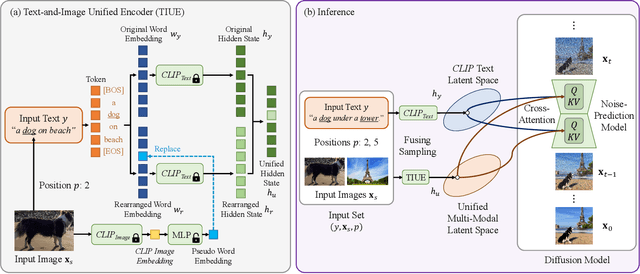
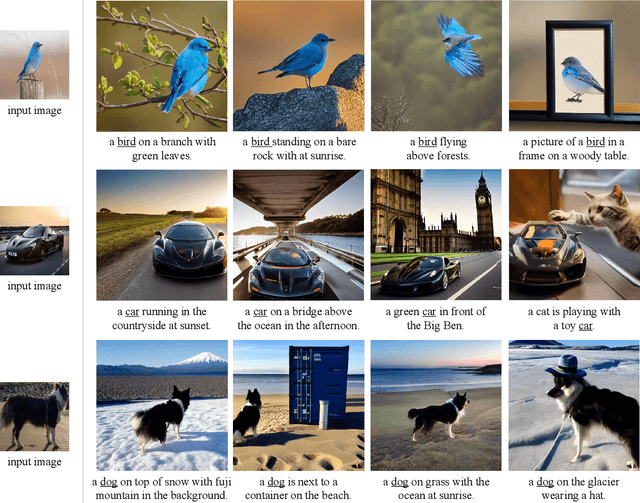
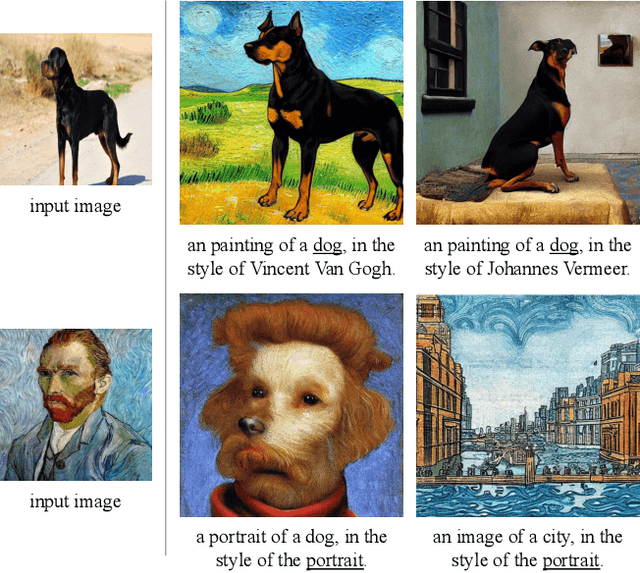
Abstract:Language-guided image generation has achieved great success nowadays by using diffusion models. However, texts can be less detailed to describe highly-specific subjects such as a particular dog or a certain car, which makes pure text-to-image generation not accurate enough to satisfy user requirements. In this work, we present a novel Unified Multi-Modal Latent Diffusion (UMM-Diffusion) which takes joint texts and images containing specified subjects as input sequences and generates customized images with the subjects. To be more specific, both input texts and images are encoded into one unified multi-modal latent space, in which the input images are learned to be projected to pseudo word embedding and can be further combined with text to guide image generation. Besides, to eliminate the irrelevant parts of the input images such as background or illumination, we propose a novel sampling technique of diffusion models used by the image generator which fuses the results guided by multi-modal input and pure text input. By leveraging the large-scale pre-trained text-to-image generator and the designed image encoder, our method is able to generate high-quality images with complex semantics from both aspects of input texts and images.
 Add to Chrome
Add to Chrome Add to Firefox
Add to Firefox Add to Edge
Add to Edge